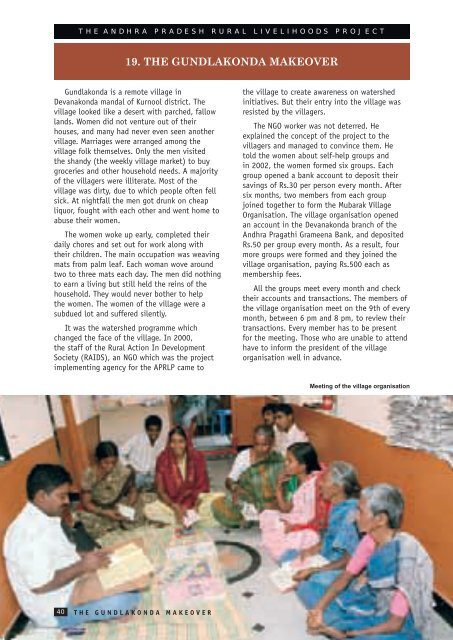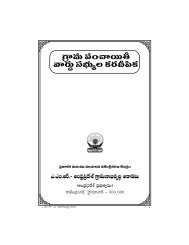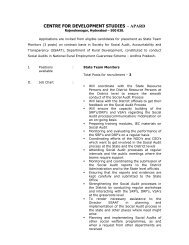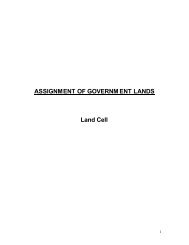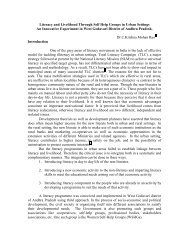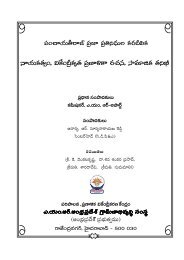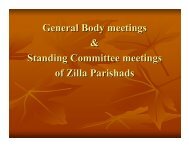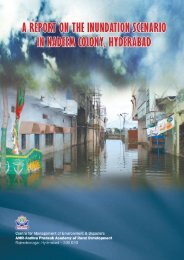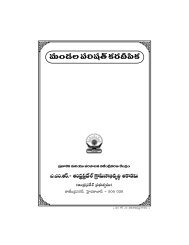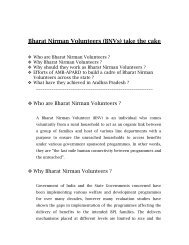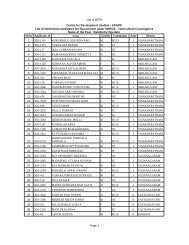HOPE Case Studies - Andhra Pradesh Academy of Rural ...
HOPE Case Studies - Andhra Pradesh Academy of Rural ...
HOPE Case Studies - Andhra Pradesh Academy of Rural ...
Create successful ePaper yourself
Turn your PDF publications into a flip-book with our unique Google optimized e-Paper software.
T H E A N D H R A P R A D E S H R U R A L L I V E L I H O O D S P R O J E C T19. THE GUNDLAKONDA MAKEOVERGundlakonda is a remote village inDevanakonda mandal <strong>of</strong> Kurnool district. Thevillage looked like a desert with parched, fallowlands. Women did not venture out <strong>of</strong> theirhouses, and many had never even seen anothervillage. Marriages were arranged among thevillage folk themselves. Only the men visitedthe shandy (the weekly village market) to buygroceries and other household needs. A majority<strong>of</strong> the villagers were illiterate. Most <strong>of</strong> thevillage was dirty, due to which people <strong>of</strong>ten fellsick. At nightfall the men got drunk on cheapliquor, fought with each other and went home toabuse their women.The women woke up early, completed theirdaily chores and set out for work along withtheir children. The main occupation was weavingmats from palm leaf. Each woman wove aroundtwo to three mats each day. The men did nothingto earn a living but still held the reins <strong>of</strong> thehousehold. They would never bother to helpthe women. The women <strong>of</strong> the village were asubdued lot and suffered silently.It was the watershed programme whichchanged the face <strong>of</strong> the village. In 2000,the staff <strong>of</strong> the <strong>Rural</strong> Action In DevelopmentSociety (RAIDS), an NGO which was the projectimplementing agency for the APRLP came tothe village to create awareness on watershedinitiatives. But their entry into the village wasresisted by the villagers.The NGO worker was not deterred. Heexplained the concept <strong>of</strong> the project to thevillagers and managed to convince them. Hetold the women about self-help groups andin 2002, the women formed six groups. Eachgroup opened a bank account to deposit theirsavings <strong>of</strong> Rs.30 per person every month. Aftersix months, two members from each groupjoined together to form the Mubarak VillageOrganisation. The village organisation openedan account in the Devanakonda branch <strong>of</strong> the<strong>Andhra</strong> Pragathi Grameena Bank, and depositedRs.50 per group every month. As a result, fourmore groups were formed and they joined thevillage organisation, paying Rs.500 each asmembership fees.All the groups meet every month and checktheir accounts and transactions. The members <strong>of</strong>the village organisation meet on the 9th <strong>of</strong> everymonth, between 6 pm and 8 pm, to review theirtransactions. Every member has to be presentfor the meeting. Those who are unable to attendhave to inform the president <strong>of</strong> the villageorganisation well in advance.Meeting <strong>of</strong> the village organisation40 THE GUNDLAKONDA MAKEOVERHope_<strong>Case</strong><strong>Studies</strong>_BK.indd 401/7/2008 10:43:28 AM


